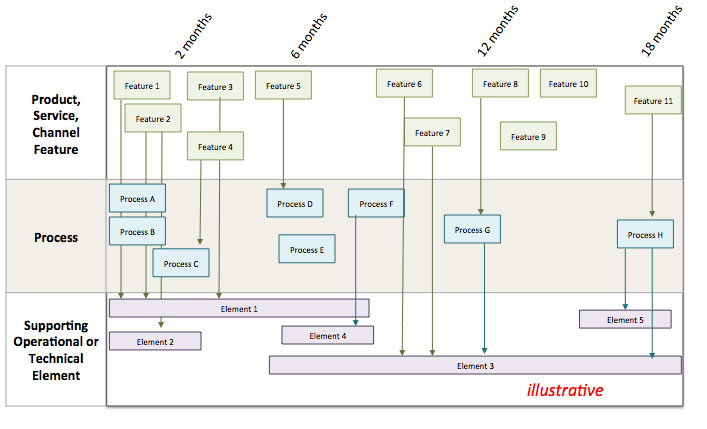Part 4: Executing The Customer Experience Design
As a reminder of where we are in the 6 part series: we have defined customer experience, we have gotten sponsorship from a strong executive and he or she has marshalled the organization, we have learned all the important things that matter for our customer experience design, we developed concepts, selected the best ones, prioritized them based on constraints, and developed a 12-18 month roadmap for execution.
Now it is time to execute it.
In this series we have split up the execution of customer experience from the management of customer experience to signal the difference between doing it once and doing it in an ongoing way. (The attitude when approaching a customer experience effort must be that it is an ongoing effort that will need resources tied to do just like any other business function. We will talk about this more in part 5 tomorrow.) The execution step is what it takes to get the design and strategy from paper to reality.
Executing the Customer Experience Design
The biggest difference in getting a product built and launched and getting a customer experience built and launched is the number of departments and functions that need to be involved. The customer experience design includes almost every part of the company: products, services, processes, channels, strategies, finance. It also involves many different types of elements that will need different approaches for execution – employee training, marketing campaigns, engineering, service, web, billing, and so on. They may not all need to be involved the entire time but if the customer experience is the Whole Offering (as we hope) you will need the full team on board.
At a high level, here is how we look at the executing step:
- Preparing the team
- Coordinated development
- Launching features
- Transitioning to management
1. Preparing the team
At the end of the design and strategy step, the team estimated the cost/effort of the customer experience concepts they had created and prioritized what needed to be developed based on customer-oriented metrics and business strategy and placed it all on the roadmap. That is not a small task so some of the work may bleed over into this step. After that is done, the next step is to ensure all the right details are in place at all levels of the roadmap, that all dependencies are correct, and that all the necessary requirements and “specs” have been documented so that the development teams can be selected and get to work.
For clarity, this is an illustrative example of what we mean by a 12 – 18 month roadmap:
This high-level illustrative roadmap shows when certain features, processes, or supporting elements of your customer experience design and strategy need to launch and which element is dependent on others. In a real roadmap you would be able to zoom in or drill down to see the details, the exact dates, the dependencies, etc. For those of you familiar with roadmaps you will note that this looks just like a product roadmap or a project roadmap. It is exactly the same except the content is tied to your customer experience design and strategy.
The development team for a whole scale customer experience effort will be broader and more cross functional than a team for a feature-level customer experience effort. In either case though the goal is to have a team that can see and influence across the organization in order to create a holistic customer experience that doesn’t have any gaps: technology, marketing, product development, service development, customer service, sales, executives, supply chain, operations, R&D, training.
We encourage our clients to kick off the team all at one time (for the entire 12 -18 month effort) to make sure everyone is aligned on the goals and knows their teammates. Team members will only actively work on the project based on the resource allocation that is tied to the roadmap plan
2. Coordinated development
Customers experience everything an organization offers them as “the offering.” They rarely make distinctions between product, service, billing, packaging, and the point of purchase, for example. This is why customer experience is so important and this why you must get the development step highly coordinated and integrated. This is the step in which organizations need to watch out that they don’t easily slip back into their normal pattern. If it isn’t well integrated- if each of your internal departments produce their part and leave it at the doorstep of the next department – the same problems will persist: the customer will experience a choppy piecemeal offering and things will fall through the cracks causing an bad experience.
3. Launching Features
With a 12 -18 month roadmap waves of features will launch at different times. This will be especially true if you already have an experience in the market and you are redesigning it. Launching customer experience features is different than launching a product; it demands more subtlety. With a product, big announcements are warranted because of the revenue numbers attached to it and/or because customers are already using it and a big change means a real change in their product experience. Most customer experience changes are enhancements that will make things better but don’t warrant a big screaming announcement. (Check out our blog on figuring out when something isn’t worth announcing.)
The launch, however, will be a big deal internally because of the development effort required and the likely change in process and behavior to support the new experience. Make sure your teams are ready, coordinated, and their accomplishment celebrated.
Here are a few customer experience changes we’ve worked on that had great impact on customers but weren’t worth announcing:
- The queuing and purchasing experience at a global quickserve food chain
- The activation process for prepaid cell phone
- The download process for a highly technical software package
- The overall experience (from prescription to injection) getting a new prescription drug for the first time
Here are a few examples of customer experience changes that were worth announcing:
- An entirely new self-service experience for engaging with an electric utility throughout the entire relationship
- A new, easier way to get problems resolved with a heavy equipment manufacturer
- A new way for doctors to set up a specific piece of medical equipment in the operating room
4. Transitioning to management
Just like product development is rarely product management, customer experience development team is very rarely the same team that manages the customer experience. The responsibilities and tasks are different. The process for managing the customer experience elements should be designed along with the elements themselves but if that doesn’t happen this team should do it before launch. It is also helpful to bring the people that will manage it on to the team before launch to get them familiar and trained before there is something to actually manage. Tomorrow we will talk about what “managing” actually means.
6 Part Blog Series: What Does It Take To Actually Make a Great Customer Experience Happen
- Sunday: What Does It Take To Actually Make a Great Customer Experience Happen
- Monday: Organizational fortitude
- Tuesday: Choosing the right experience (for your customers)
- Wednesday: Executing it
- Thursday: Managing it
- Friday: Making Changes
Originally published on September 25, 2013

